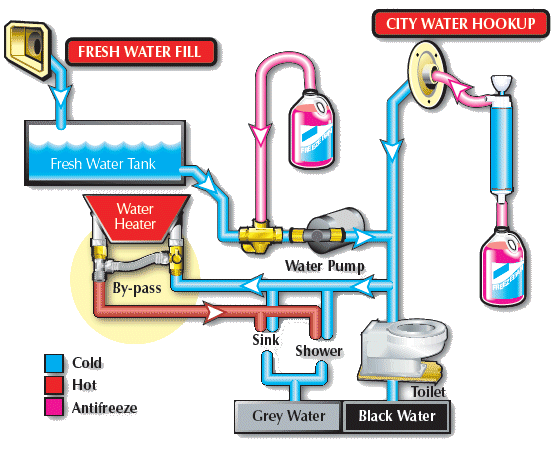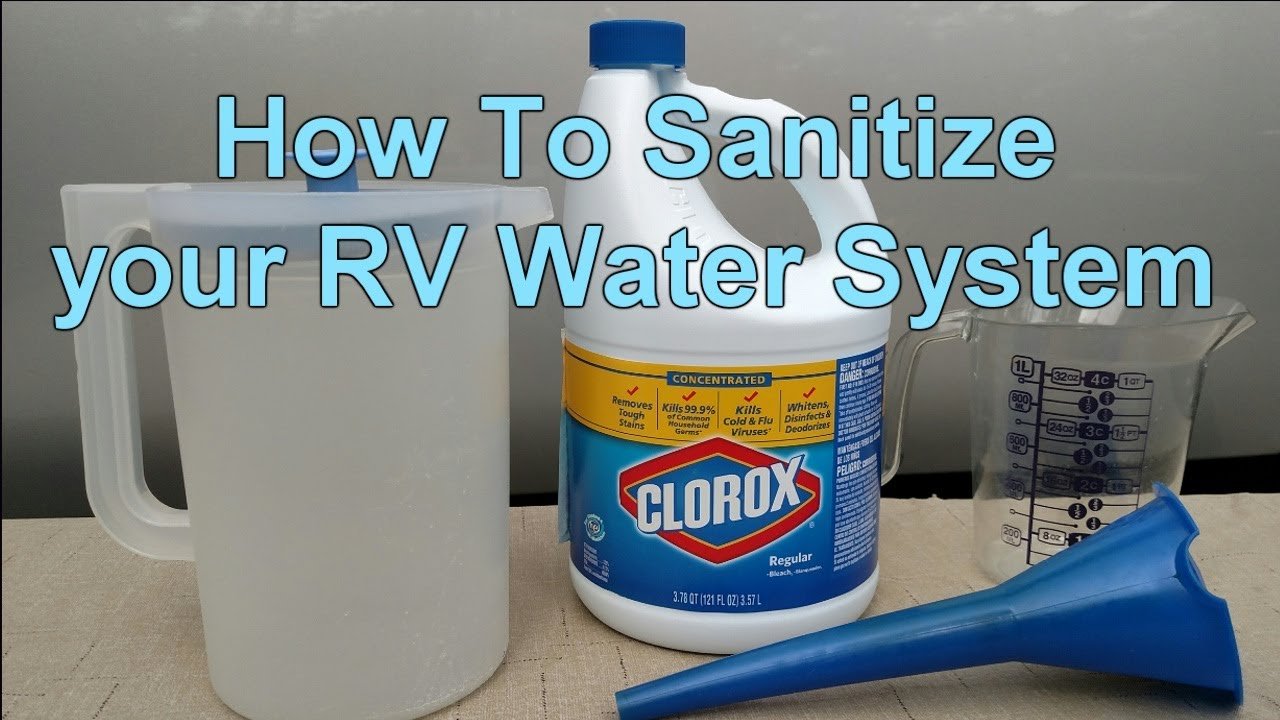No, you should not put RV antifreeze in the freshwater tank. RV antifreeze is designed for plumbing systems, not for drinking water.
Maintaining your RV during winter is crucial. Many people wonder about the use of RV antifreeze. It is essential to understand its purpose and safe application. The freshwater tank holds your drinking water. Mixing it with antifreeze can be harmful.
This blog will explain why you shouldn’t add RV antifreeze to the freshwater tank. We will also discuss alternative methods to protect your RV’s water system during cold months. Stay informed and keep your water system safe.
Why Use Rv Antifreeze?
RV antifreeze protects your freshwater tank from freezing in cold weather. It prevents damage to pipes and pumps. Using it ensures your RV’s water system stays safe.
Using RV antifreeze in your freshwater tank is crucial for winterizing your RV. It keeps your plumbing system safe during freezing temperatures. Let’s dive into the reasons why RV antifreeze is so important.
Preventing Freezing
RV antifreeze helps keep your water lines from freezing. Water expands when it freezes, causing pipes to burst. This can lead to costly repairs. By using antifreeze, you ensure that the water in your lines stays liquid. Even in cold weather, your pipes remain intact.
Protecting Plumbing
RV antifreeze protects your plumbing system. It prevents damage from freezing temperatures. It also helps in keeping your pump, valves, and other components safe. Without antifreeze, these parts could crack or break. That would mean expensive replacements. Using antifreeze saves you money and hassle. By adding RV antifreeze, you maintain the longevity of your RV’s plumbing system. It’s a simple step with big benefits. Your RV stays in good shape, ready for your next adventure. “`

Credit: blog.campingworld.com
Types Of Rv Antifreeze
Choosing the right RV antifreeze is essential for winterizing your vehicle. Different types of RV antifreeze offer varying levels of protection and efficiency. Understanding the types can help you make an informed decision.
Ethanol-based
Ethanol-based antifreeze is a common choice for RV owners. It contains ethanol, a type of alcohol that prevents freezing. This type is often cheaper than other options. It is effective in preventing ice formation in your pipes.
However, ethanol-based antifreeze has some downsides. It can leave an unpleasant taste and odor in your water system. Over time, it may also dry out rubber seals and hoses. This can lead to leaks and other issues in your RV’s plumbing system.
Propylene Glycol-based
Propylene glycol-based antifreeze is another popular option. It is non-toxic and safe for use in your freshwater system. This type does not leave a bad taste or smell. It is also less likely to damage rubber seals and hoses.
Propylene glycol-based antifreeze provides excellent protection against freezing. It is suitable for use in drinking water systems. It can be a bit more expensive than ethanol-based options. But, its safety and effectiveness make it a worthwhile investment.
Is It Safe For Freshwater Tanks?
Using RV antifreeze in freshwater tanks is not safe. It can be toxic and harm both the tank and its users. Always choose antifreeze designed specifically for potable water systems.
When winter approaches, many RV owners worry about protecting their water systems from freezing. RV antifreeze is often used to prevent damage. But, is it safe to put it in the freshwater tank? This question arises due to health and environmental concerns. Let’s explore these aspects in detail.
Health Concerns
RV antifreeze is specially formulated to be non-toxic. But, it is still a chemical. Ingesting large amounts can cause health issues. While the antifreeze in your freshwater tank will be flushed out, residues might remain. This can be risky, especially for young children and pets. Here are a few points to consider: – Non-toxic does not mean safe for consumption. – Chemical residues can affect the taste of water. – Sensitive individuals might experience reactions.
Environmental Impact
Using RV antifreeze in your freshwater tank can also have an environmental impact. When you flush out the antifreeze, it enters the environment. While non-toxic, these chemicals can still affect local ecosystems. Consider these environmental impacts: 1. Contamination of soil and water sources. 2. Harm to aquatic life due to chemical residues. 3. Long-term environmental effects from repeated use. In summary, while using RV antifreeze can protect your water system, it poses health and environmental risks. Always weigh these factors carefully. Ensure you follow proper procedures to minimize any potential hazards. “`
Steps To Add Antifreeze
Adding RV antifreeze to your freshwater tank is essential for winterizing your RV. Proper winterization helps prevent damage to the plumbing system. Here are the steps you need to follow to add antifreeze to your RV’s freshwater tank.
Draining The Tank
First, drain all water from the freshwater tank. Turn off the water pump. Open all faucets and let the water flow out. Don’t forget to flush the toilet until no water remains. Ensure all water drains from the system. This step is crucial before adding antifreeze.
Adding The Antifreeze
Once the tank is empty, you can add the antifreeze. Use a funnel for easy pouring. Open the faucet closest to the tank. Slowly pour the antifreeze into the tank. Ensure it moves through the entire system. Turn on the water pump briefly to help distribute the antifreeze. Open each faucet one at a time until you see pink antifreeze flowing. Don’t forget to run antifreeze through the shower and toilet. This ensures all water lines are protected.
Flushing The System
Flushing the system is vital after using RV antifreeze in the freshwater tank. This ensures no residue remains, keeping the water safe for use. Follow these steps to properly flush your system.
Removing Antifreeze
First, you need to remove all the antifreeze from the tank. Open all faucets, including hot and cold, to allow the antifreeze to flow out. You may see pink liquid, which indicates antifreeze. Keep the faucets open until clear water flows.
Next, flush the toilet several times. This clears the antifreeze from the plumbing system. Don’t forget to open the shower and outdoor taps too. Every point where water flows should be cleared of antifreeze.
Pro Tip: Use a hose to connect to an external water source. This helps to push the antifreeze out more efficiently.
Sanitizing The Tank
After removing the antifreeze, sanitize the freshwater tank. This step ensures the water is clean and safe. Use a mixture of bleach and water. Add a quarter cup of bleach for every 15 gallons of water in the tank.
Pour the bleach mixture into the freshwater tank. Run the water through all faucets until you smell bleach. Let the solution sit in the system for at least 12 hours. This kills any bacteria or germs.
Finally, drain the tank and refill it with fresh water. Run the water through all faucets again to remove any bleach residue.
Repeat this process until you no longer smell bleach in the water. This ensures your system is fully sanitized and ready for use.
| Step | Action |
|---|---|
| 1 | Open all faucets |
| 2 | Flush toilet multiple times |
| 3 | Use hose to push antifreeze out |
| 4 | Sanitize with bleach mixture |
| 5 | Drain and refill with fresh water |
| 6 | Run water until no bleach smell |
Common Mistakes To Avoid
Avoid putting RV antifreeze in your freshwater tank. Doing so can contaminate your drinking water. Always use the correct antifreeze for the intended system.
Using RV antifreeze in the freshwater tank can prevent freezing. But, there are common mistakes that many make. These errors can lead to issues. Let’s discuss some of these common mistakes.
Using The Wrong Type
Using the wrong type of antifreeze can cause problems. Not all antifreeze products are safe for drinking water systems. Make sure to use RV antifreeze specifically designed for freshwater systems. Read labels carefully to ensure safety.
Incorrect Dilution
Incorrect dilution is another common mistake. Some people dilute the antifreeze too much. This reduces its effectiveness. Always follow the manufacturer’s instructions. Use the correct amount to ensure your system is protected. Diluting it too much can leave your pipes vulnerable. “`
Alternatives To Rv Antifreeze
Alternatives to RV antifreeze are crucial for those who prefer different methods to winterize their RV. While RV antifreeze is effective, some RV owners seek other options to protect their water systems from freezing temperatures. Here are two popular alternatives: the air compressor method and heated storage solutions.
Air Compressor Method
The air compressor method is a popular alternative to using RV antifreeze. This method involves blowing out the water from your RV’s plumbing system. An air compressor is used to push air through the water lines, removing any remaining water. This prevents the water from freezing and causing damage.
First, drain all the water tanks and open all faucets. Attach the air compressor to the city water inlet. Set the air pressure to 30-40 PSI. Blow out each faucet, one at a time, until no water remains. Don’t forget to blow out the toilet, shower, and any external water connections. This method ensures no water is left in the system.
Heated Storage Solutions
Storing your RV in a heated facility can also prevent your water system from freezing. Heated storage solutions keep the temperature above freezing, protecting your RV’s plumbing. These facilities maintain a consistent temperature, ensuring your RV is safe from harsh winter conditions.
Find a local storage facility that offers heated storage options. Make sure the facility is secure and well-maintained. This option can be more expensive but provides peace of mind. Your RV will be ready to use when the weather warms up, without the need for de-winterizing.
Winterizing Tips
Winterizing your RV is essential to prevent damage during the cold months. One critical step is to protect your freshwater system. Should you put RV antifreeze in the freshwater tank? This guide covers important winterizing tips to keep your RV in top shape.
Regular Maintenance
Perform regular maintenance before winter sets in. Clean your freshwater tank thoroughly. Remove any residue or buildup. This prevents contaminants from causing issues later. Regular maintenance helps ensure your RV stays in good condition.
Checking For Leaks
Check for leaks in your RV’s plumbing system. Leaks can cause serious damage if left untreated. Inspect all pipes, hoses, and connections. Look for any signs of wear or damage. Fix any leaks before adding antifreeze. This step is crucial to prevent freezing and bursting pipes.
Frequently Asked Questions
Can You Put Rv Antifreeze In The Freshwater Tank?
No, you should not put RV antifreeze in the freshwater tank. It’s designed for the plumbing system, not for drinking water.
How Do You Winterize An Rv’s Freshwater Tank?
To winterize, drain the tank completely, then blow out the lines with compressed air. Avoid using antifreeze in the freshwater tank.
Is Rv Antifreeze Safe For Drinking Water?
No, RV antifreeze is not safe for drinking water. It’s non-toxic but not meant for consumption.
What Is Rv Antifreeze Used For?
RV antifreeze is used to prevent the plumbing system from freezing. It’s not intended for the freshwater tank.
Conclusion
Using RV antifreeze in your freshwater tank isn’t recommended. It can be unsafe. Instead, winterize your RV properly. Drain and bypass the freshwater system. Use antifreeze only in the plumbing. This keeps drinking water clean and safe. Always follow manufacturer instructions.
Proper care extends the life of your RV. Stay safe and enjoy your travels!





